Shure 888TT Microphone
GENERAL DESCRIPTION
The 888TT handheld, amplified, noise-canceling DTMF communications microphone is FAA Certified for aircraft application (TSO-C58a). In addition to its extremely clear transmission, even in noisy environments, the 888TT has very low sensitivity to hum pickup and low susceptibility to radio frequency interference.
Audio and DTMF levels can be independently adjusted with the supplied screwdriver to match the transmitter input gain. These protected external controls prevent accidental changes by the user while allowing adjustments without having to disassemble the microphone case.
The illuminated keypad is made of tough silicone rubber, with durable printed characters that will last the life of the microphone. The keypad is backlit by red LEDs, easily visible during night operation, minimizing eye readjustment for night vision.
The 888TT may be used with most currently available aircraft radios. For convenience, all microphone and signaling functions, including keypad illumination, are powered directly from the microphone input circuit of most transmitters, reducing the need for equipment modification. A five-conductor MODULINK® cable (sold separately) connects the modular telephone-type socket of the 888TT to most aircraft radios using a PJ-068 plug. This cable can be instantly changed or replaced without soldering.
The 888TT is ergonomical, fitting naturally and comfortably in the hand. The voice-entry port is at the top of the microphone body for simple, natural transmitting. The microphone is not affected by heat or humidity, and the rugged ARMO-DUR® case is immune to oil, grease, most fumes and solvents, salt spray, sun, rust and corrosion. The 888TT is outstanding in its ability to withstand mechanical shocks and vibration. Its Million-Cycle Plus™ leaf-type switch is a double-pole, single-throw type that resists the effects of severe operating conditions and constant use. It has nickel-silver blades with palladium alloy contacts for reliable oxidation-free operation.
The microphone is supplied with output levels factory preset to meet TSO-C58a requirements. Adjustments should be made only by an FAA Approved Service Facility or the Shure Service Department.
The 888TT is supplied with a small screwdriver for releasing the modular-plug microphone cable from the case and for adjusting the microphone amplifier gain and DTMF level. A mounting loop is supplied affixed to the microphone, and mounting brackets for attaching to radio equipment or other surfaces are available in quantities of three as Shure RK6MB.
PART OF A COMPLETE LINE
The 888TT is part of a full line of mobile microphones, circuitry products and related accessories.
For a complete listing, contact your Shure Representative or visit www.shure.com.
APPLICATIONS
- Aerospace
FEATURES
- FAA CERTIFIED FOR AIRCRAFT USE
- DETACHABLE MODULINK® MODULAR PLUG COIL CORD WITH PJ-068 AIRCRAFT-RADIO PLUG OR A4M TYPE CONNECTOR
- NOISE-CANCELING WITH FREQUENCY RESPONSE TAILORED FOR OPTIMUM INTELLIGIBILITY
- TOP-TALK SOUND CHANNEL™ FOR CLEAR VOICE INPUT, EASY HANDLING
- BUILT-IN TRANSISTOR AMPLIFIER POWERED BY CARBON-MICROPHONE-TYPE CIRCUIT
- ILLUMINATED KEYPAD WITH POSITIVE TACTILE CONFIRMATION AND AUDIBLE VERIFICATION TONES
- SIMPLE EASY-TO-USE CONTINUOUS-TONE DIALING
- SCREWDRIVER ACCESSIBLE DTMF LEVEL ADJUSTMENT, INDEPENDENT OF MICROPHONE GAIN SETTING
- LOW SENSITIVITY TO HUM AND RF INTERFERENCE
- RUGGED MILLION-CYCLE PLUS™ LEAF-TYPE SWITCH STANDS UP UNDER SEVERE ENVIRONMENTS AND CONSTANT USE
- HIGH IMPACT ARMO-DUR® CASE, STRONG, LIGHTWEIGHT, COMFORTABLE TO THE TOUCH IN HOT OR COLD ENVIRONMENTS
- RUGGED AND DEPENDABLE UNDER ALL OPERATING CONDITIONS
SET-UP
The 888TT is equipped with a hang-up loop and a rear-case hang-up button for use with a mounting bracket on associated equipment.
Heavy-duty chrome-plated mounting brackets are available in quantities of three as Shure Part No. RK6MB.
CONNECTIONS
To attach the cable to the 888TT, insert the modular telephone-type plug in the microphone jack until it locks.To remove the cable from the microphone, insert the small screwdriver supplied with the 888TT in case hole “A” just above the cable jack (see Figure 4) to unlock the plug and withdraw the plug from the jack. Microphone connector wiring is shown in the table below. The ALM-88 cable is wired at the microphone connector as shown in Figure 3.
Table 1. Microphone Connector Wiring

OPERATION
Voice Transmission
- Hold the microphone comfortably in the hand positioned so that the Top-Talk Sound Channels™ at the top of the case are near the mouth.The clearest sound is often obtained with the microphone at the corner of the mouth, with the cable away from the face.
- Depress the push-to-talk button and make sure the equipment is in the transmit mode before speaking.
Dialing
- Press and hold the push-to-talk button.
- Press the desired keypad buttons in sequence.A high-pitched tone will confirm that the code has been transmitted. (The microphone audio is muted during DTMF tone transmission.)
Operation of microphone and DTMF functions requires that the 888TT be connected to the communications equipment and that the equipment power is turned on.
After connection to the communications set, turn the equipment power On. Pressing the push-to-talk switch and observing the keypad LED backlighting can verify power application.
Factory preset microphone audio and DTMF levels are correct for aircraft radios with standard input circuits (as defined in RTCA DO-170), and level adjustment should not ordinarily be necessary. When such adjustment is necessary, it should be performed only by Shure Incorporated or by an FAA Approved Service Facility.
Use the supplied screwdriver to adjust the microphone sensitivity and DTMF output levels as follows:
- Microphone sensitivity: Press the push-to-talk button and speak normally into the microphone while checking transmitter modulation.Adjust the microphone sensitivity control (case back, hole “B” in Figure 4) and repeat the talk test as required.
- DTMF output: Press and hold the push-to-talk button. Depress and hold down a keypad button for a continuous tone. Adjust the DTMF output control (case back, hole “C” in Figure 4) as required.
SPECIFICATIONS
Type
Electret condenser, noise canceling, with transistor pre-amplifier, DTMF signaling circuitry, illuminated keypad
Frequency Response
200 to 4,000 Hz (see Figure 1)
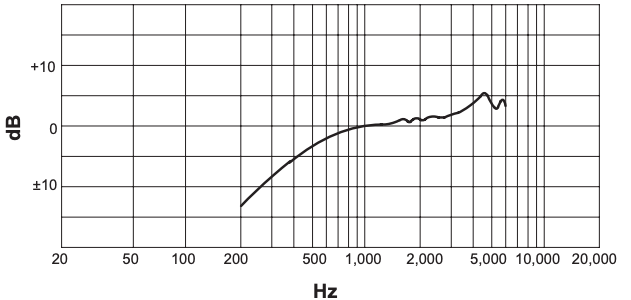
TYPICAL FREQUENCY RESPONSE
FIGURE ONE
Polar Pattern
Bidirectional, noise canceling
Electrical Characteristics

*Standard electrical test circuit per RTCA DO-170**Microphone is powered only while PTT switch is depressed (standby current = 0 if PTT switch is released)
Environmental Conditions
Operating Temperature: -40 to 60° C (-40 to 140° F)Storage Temperature: -54 to 85° C (-65 to 185° F)Relative Humidity: 0 to 95% (non-condensing)
Microphone Connector
6-conductor modular telephone type
PTT Switch Assembly
Mechanical: Double-pole, single-throw, leaf-type, normally open
Cable
ALM-88, detachable MODULINK®, 1.8 m (6 ft) extended cord with modular plug on microphone end and PJ-068 aircraft connector on equipment end; and ALM-89 with A4M type connector.
Construction
Case: Black textured high-impact ARMO-DUR®Switch Button: Black ARMO-DUR®Keypad: Molded silicone rubberHang-up Loop: Matte finish stainless steel
Dimensions
See Figure 2
Net Weight (including cable and connector)
283 g (10 oz)
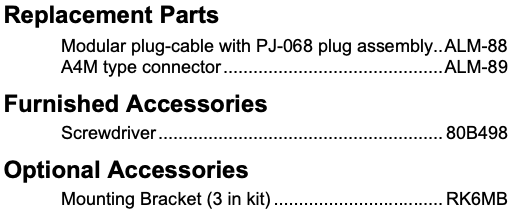
FAA Certification
The Model 888TT is FAA Certified for aircraft use under FAA TSO-C58a requirements. To maintain this FAA Certification, any service required for the Model 888TT must be performed by Shure Incorporated or by an FAA Approved Service Facility.
FIGURES
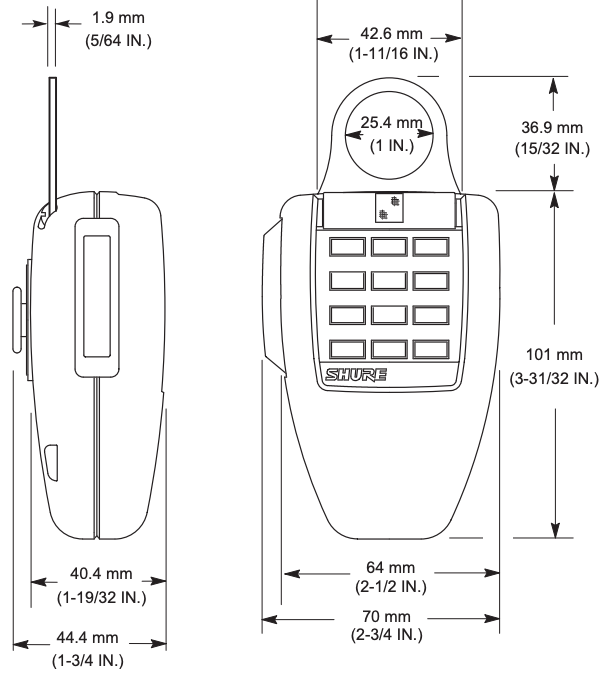
OVERALL DIMENSIONS
FIGURE TWO

MODULINK CABLE WIRING
FIGURE THREE
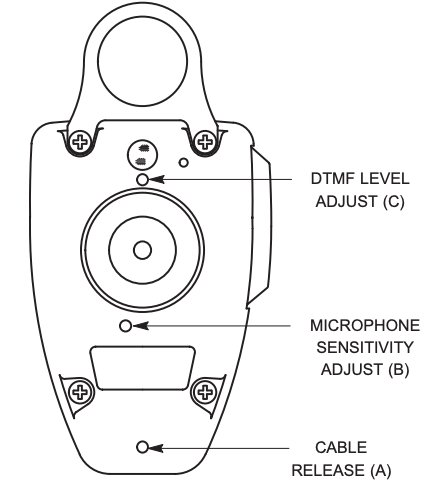
MICROPHONE CASE BACK
FIGURE FOUR
ENVIRONMENTAL QUALIFICATION FORM,TSO-C58A
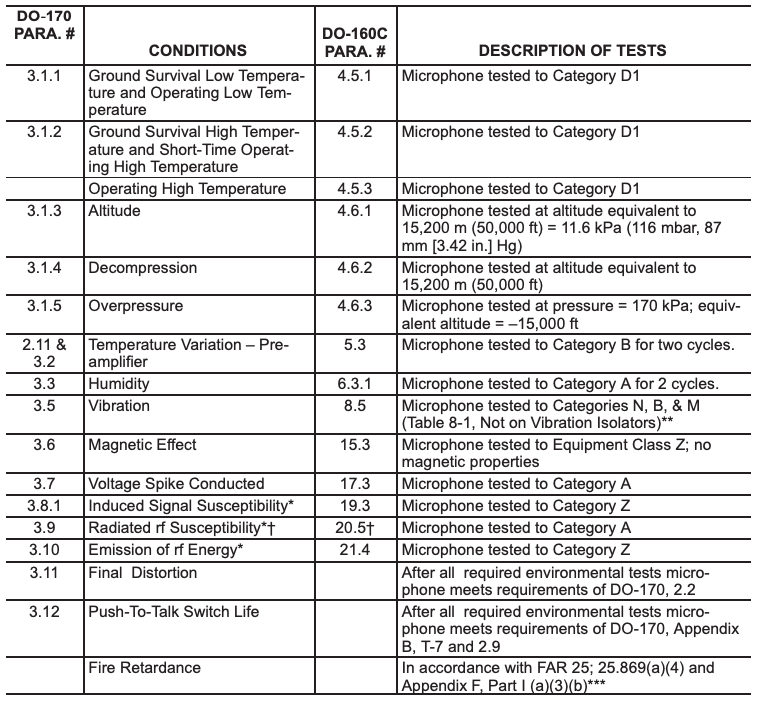
*Tests performed at Radiometrics Midwest Corporation, Lombard, IL†Tested to DO-160B**Tests performed at Elite Electronic Engineering, Downers Grove, IL***Tests performed at Gaynes Test Laboratories, Chicago, ILAll other tests performed at Shure Inc., Evanston, IL
INFORMATION TO USERS
This equipment has been tested and found to comply with the limits for a Class B digital device pursuant to Part 15 of the FCC Rules. These limits are designed to provide reasonable protection against harmful interference in a residential installation. This equipment generates, uses, and can radiate radio frequency energy, and, if not installed and used in accordance with the instructions, may cause harmful interference to radio communications. However, there is no guarantee that interference will not occur in a particular installation.
If this equipment does cause harmful interference to radio or television reception, which can be determined by turning the equipment off and on, the user is encouraged to try to correct the interference by one or more of the following measures:
- Reorient or relocate the receiving antenna.
- Increase the separation between the microphone and receiver.
- Connect the microphone transmitter into an outlet on a circuit different from that to which the receiver is connected.
Consult the dealer or an experienced radio/TV technician for help.
Shure 888TT Microphone User Manual – Shure 888TT Microphone User Manual –
[xyz-ips snippet=”download-snippet”]

